|
FAQs about the Striped Sailfin Tangs,
Zebrasoma desjardinii, Z. veliferum:
Identification
Related Articles: Striped Zebrasoma Tangs, the Genus Zebrasoma,
Related FAQs: Striped Sailfin Tangs 1, Striped Sailfin Tangs 2, & FAQs
on: Striped Sailfin Tangs
Behavior, Striped Sailfin
Tangs Compatibility, Striped Sailfin Tangs Selection,
Striped Sailfin Tangs
Systems, Striped Sailfin
Tangs Feeding, Striped
Sailfin Tangs Disease, Striped Sailfin Tangs
Reproduction, & Zebrasomas
I, Yellow Tangs, Purple Tangs, Surgeons In General, Selection, Tang Behavior, Compatibility, Systems, Feeding, Disease,
|
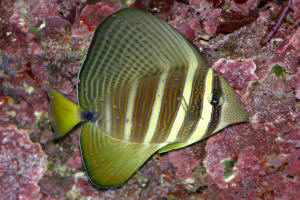 Fishbase.org lists two
species... Fishbase.org lists two
species...
|
Surgeonfishes: Tangs for Marine Aquariums
Diversity, Selection & Care
New eBook on Amazon: Available here
New Print Book on Create Space: Available
here
by Robert (Bob) Fenner |
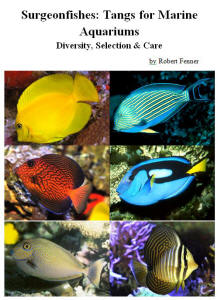 |
|
Tang ID / Coral ID & Advice 5/29/13
Hi Bob, Crew:
<Kevin>
It's been a while since I've written, the last time you may recall a few
years back resulted in a Chloroquine Phosphate experiment in a 300
gallon display. I am hoping you can help me identify two species in a
tank I have recently adopted.
The first, the Tang appears to me to be a Zebrasoma species, I am
leaning toward veliferum; however, the tail markings are not consistent
with what I read on your site. Can you ID the species and tell if it is
a juvenile or adult?
<It is as you state; not quite an adult... grows to more than plate size
in the wild; turns dark>
Secondly, we have a problematic / unhealthy handful of what appear to be
Sinularia spp.
<Agreed>
I moved them toward the top of the tank nearer to the MH lighting and in
an area of increased flow about a week ago. Most were near the bottom
with weak flow prior. Can you help me ID the species or at least confirm
I am headed in the right direction?
<Don't need much flow; but do have other specific needs... is there
measurable NO3, HPO4 here?>
As you can see from the image,
the animal is not happy. The 125 gallon tank has been in place about 60
days with good, stable water parameters being 0 Ammonia, 0 Nitrite, No
traceable nitrates and S.G. of 1.025-26. 3-150 Watt MH (10,000k), 8
actinic florescent, with 12 hour photo period. I have targeted with
iodine, strontium, and calcium alternate with carbon in the sump /
refugium overflow chambers.
<... [Ca], [Mg], alkalinity? Other Cnidarian life present?>
I have included an overall view of the reef so you have a point of
reference. The (Sinularia) species in question is right of the Kenya
Tree near the top right of the image. It was moved from the far left,
bottom where the red mushrooms are now.
<These are likely winning out over the Alcyonaceans... see WWM re them
(compatibility FAQs) and allelopathy>
I do not believe the tank is overcrowded;
although, there is a wide range of SPS, LPS, and soft coral. Everything
else appears happy, healthy.
<Not all>
Thank you for your input!
Kevin
<Read on! Bob Fenner>
|
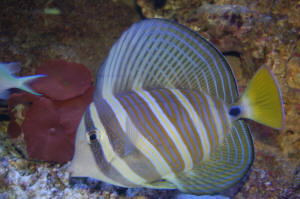
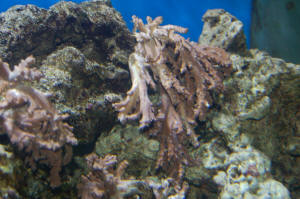
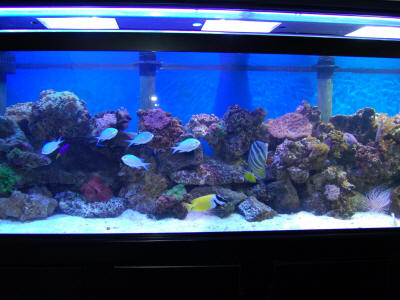 |
Is this (Zebrasoma veliferum) the same species as Z. desjardinii
of the I.O., RS Bob: Looks like veliferum to me? Photo from the
Pacific? <Yes, also off the dry side of the Big Island> Z.
desjardinii of the Indian Ocean is a valid species close to
veliferum. <Ah, had read some accounts the latter was
considered a junior synonym now...> Different fin-ray counts as well
as some color differences. Aloha, Jack <Thank you for this Jack.
Will add to the Zebrasoma FAQs on our www.WetWebMedia.com site. Bob
Fenner><<Jack is Dr. John Randall, Bernice P. Bishop Museum.
RMF>>
Re: Is this (Zebrasoma veliferum) the same species as Z.
desjardinii of the I.O., RS <Response to daily pic email out by
Werner Schmettkamp, BSV in Germany, owners/publishers of the mag. das
Aquarium and Sven and Alf's fab Modern Coral Reef Aquarium
books....> Dear Bob, it is indeed Zebrasoma veliferum, cause of the
unspotted yellow tail fin. <Danke mein Herr. Be seeing you... this
May at Interzoo. Bob Fenner> Take care, Werner
Indian Ocean v. Red Sea Sailfin III 11/11/03 In Calfo and
Fenner's new book Reef Invertebrates they list Z. veliferum as a
potential bubble algae control creature; did they mean to
include all members thereof (including the Pacific or
Hawaiian Sailfin) or is the Desjardin Sailfin the one commonly believed
in aquaristics to be the right candidate? <as stated in the last
e-mail, my friend... they are the same species (Desjardin/red sea
Sailfin is simply a Z. veliferum) but anecdotally they are believed to
be more inclined to rasp bubble algae: <<it is possible that a
race of fishes (same species...different locale) is evolved or
predisposed to eating some prey items over another. There is a strong
belief in aquaristics that this is the case with the Red Sea
Sailfin>> best regards, Anthony> <<Fishbase.org lists
two species... RMF>>
|
Zebrasoma desjardinii or Zebrasoma veliferum
1-10-08 Hello crew, <Yunachin here> I am not sure if
this tang (picture attached) is Zebrasoma desjardinii or
Zebrasoma veliferum. When I purchased him it was sold as
Zebrasoma desjardinii but I am leaning toward it being Zebrasoma
veliferum. <I am going to say that if this is an adult
specimen then it is in fact the Zebrasoma veliferum. The
differences between the two species are the markings on the tail,
where an adult desjardinii will have a spotted tail and an adult
veliferum will have the yellow tail. If this is a juvenile you
are going to have to wait it out to see if the colors change.
Here is a link as well for some more info on the two :
http://www.wetwebmedia.com/stripedzebrasomas.htm > Thanks
much
John Maggio
|
|
 very nice very nice
|
Surgeonfishes: Tangs for Marine Aquariums
Diversity, Selection & Care
New eBook on Amazon: Available here
New Print Book on Create Space: Available
here
by Robert (Bob) Fenner |
 |
|
|

